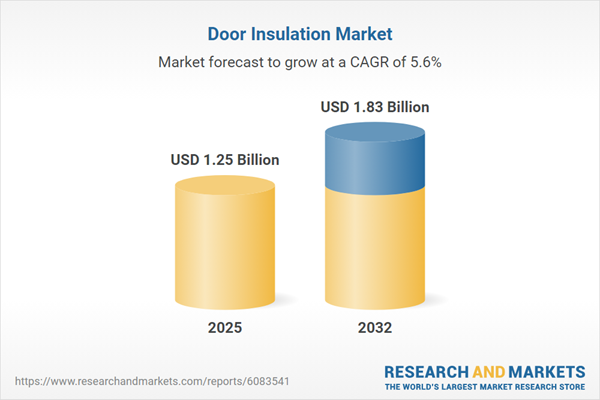Speak directly to the analyst to clarify any post sales queries you may have.
As companies address stricter sustainability goals, the door insulation market is gaining strategic attention due to increased innovation, tougher regulations, and the need for reliable supply chains. Senior decision-makers require a precise understanding of the door insulation market to successfully align operational performance, regulatory compliance, and resource allocation strategies.
Market Snapshot: Door Insulation Market Outlook
The global door insulation market is experiencing consistent growth, driven by expanding requirements for energy-efficient buildings and compliance with modern environmental benchmarks. Rising awareness of occupant comfort and regulatory enforcement further accelerates demand. In response, leading firms are advancing new technologies and adopting adaptive business strategies to match evolving needs in construction, renovation, and retrofitting projects. The industry is marked by robust competition among established insulation brands, active suppliers, and innovative technology developers who tailor solutions for the distinct needs of commercial, industrial, and residential markets.
Scope & Segmentation
This report provides in-depth perspectives for leaders seeking strategic clarity across current and emerging segments, relevant technologies, and critical regional influences in the door insulation market:
- Material: Expanded Polystyrene; Extruded Polystyrene; Fiberglass; Mineral Wool; Polyisocyanurate Foam; Polyurethane Foam. Each of these materials should be evaluated for its balance of performance, sustainability metrics, and relative cost for targeted applications and building types.
- Product Type: Blankets and Rolls; Loose Fill; Panels and Boards; Spray Foam. Product selection impacts both acoustic and thermal performance while shaping delivery timelines and installation complexity in varied building projects.
- End Use: Commercial; Industrial; Residential. A nuanced understanding of end-use context guides specification development and supports bids that require adherence to both local and industry-wide standards.
- Installation Mode: New Installation; Renovation. Each mode introduces different challenges in logistics, expertise, and supply management, essential for resource planning and flexible project execution.
- Geography: Americas (North America, Latin America); Europe; Middle East & Africa (Western & Eastern Europe, Middle East, Africa); Asia-Pacific (including China, India, Japan, Australia, Southeast Asia). Geographical variation affects everything from regulatory demands to climate-driven specifications, making a regional approach to market and channel strategy essential.
- Companies Featured: Owens Corning; Knauf Insulation GmbH; Johns Manville Corporation; Saint-Gobain S.A.; ROCKWOOL International A/S; Kingspan Group plc; The Dow Chemical Company; BASF SE; 3M Company; DuPont de Nemours, Inc. Analysis includes key innovation drivers and partnership opportunities within this company landscape.
Key Takeaways: Strategic Insights for Senior Leaders
- Green building targets and regulatory objectives are leading stakeholders to prioritize advanced, sustainable door insulation options suited for energy-efficient structures.
- Product innovations span not only enhanced energy and sound insulation but also an increasing integration of bio-based and recycled input materials, driven by environmental imperatives and user preferences.
- Supply chain strategies are shifting as organizations respond to disruptions by engaging with local suppliers, diversifying material sources, and optimizing procurement methods to reduce potential vulnerabilities.
- The adoption of digitalized manufacturing and prefabrication is supporting improved reliability in performance, reducing material waste, and accelerating installation timelines, both in new construction and renovation projects.
- Regional differentiation in climate, policy enforcement, and building practices is making it increasingly important for organizations to design localized strategies for product adaption and market penetration.
- Collaboration between insulation suppliers, manufacturers, and end-users is resulting in project-specific solutions that address unique site requirements, boosting operational flexibility and customer satisfaction.
Tariff Impact
Recent tariff actions, most notably in the United States, have created cost pressures for insulation material procurement. Major manufacturers are responding by expanding local sourcing agreements and investigating alternative materials, which has helped to bolster risk management and stimulate domestic innovation, ultimately enhancing long-term supply resilience within the market.
Methodology & Data Sources
This market analysis integrates a comprehensive review of industry-specific literature, patent filings, and regulatory frameworks, combined with interviews targeting senior executives, research specialists, and procurement managers. Findings are strengthened through quantitative assessments of pricing structures, tariff impacts, and validations with third-party experts to ensure actionable and reliable market insights.
Why This Report Matters
- Enables leadership teams to effectively manage changing technology, shifting policies, and evolving competitive dynamics across the door insulation sector.
- Supports resource optimization by delivering insights that refine sourcing tactics, accelerate sustainability initiatives, and develop region-specific go-to-market strategies.
- Empowers organizations with data to guide strategic decision-making around supply chain trends, R&D priorities, and expansion planning in response to broader global developments.
Conclusion
This report equips senior decision-makers with actionable, data-driven perspectives on trends, regulations, and technological advances in the door insulation market, supporting stronger competitive strategies and long-term sustainability objectives across relevant regions.
Table of Contents
3. Executive Summary
4. Market Overview
7. Cumulative Impact of Artificial Intelligence 2025
Companies Mentioned
The companies profiled in this Door Insulation market report include:- Owens Corning
- Knauf Insulation GmbH
- Johns Manville Corporation
- Saint-Gobain S.A.
- ROCKWOOL International A/S
- Kingspan Group plc
- The Dow Chemical Company
- BASF SE
- 3M Company
- DuPont de Nemours, Inc.
Table Information
| Report Attribute | Details |
|---|---|
| No. of Pages | 187 |
| Published | October 2025 |
| Forecast Period | 2025 - 2032 |
| Estimated Market Value ( USD | $ 1.25 Billion |
| Forecasted Market Value ( USD | $ 1.83 Billion |
| Compound Annual Growth Rate | 5.6% |
| Regions Covered | Global |
| No. of Companies Mentioned | 11 |









